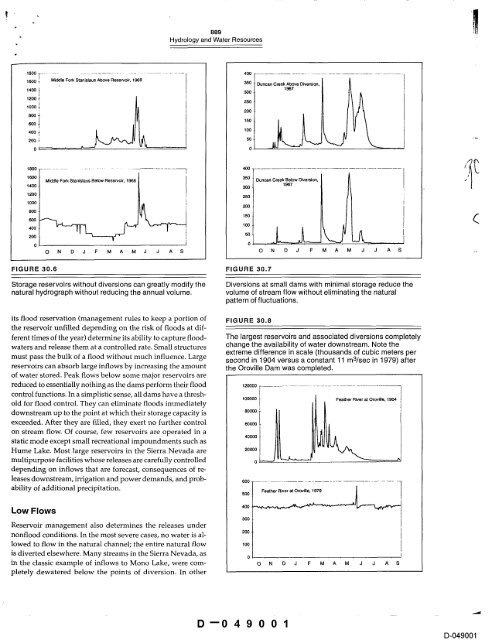D--048966 - CALFED Bay-Delta Program - State of California
D--048966 - CALFED Bay-Delta Program - State of California
D--048966 - CALFED Bay-Delta Program - State of California
You also want an ePaper? Increase the reach of your titles
YUMPU automatically turns print PDFs into web optimized ePapers that Google loves.
1800 ~<br />
1600 ~<br />
1200 ~<br />
1000 ~<br />
1800 ............<br />
Middle Fork Stanislaus Above Reservoir, 1968<br />
889<br />
Hydrology and Water Resources<br />
Duncan Creek Above D;ve~si<strong>of</strong>l<br />
1600<br />
Middle Fork Stani$1aus Below Resentoir, 1968/<br />
350<br />
Duncan Creek Below Diversion,<br />
1400 ¯ 1967<br />
O00<br />
1200<br />
1000<br />
800.<br />
~--<br />
O N D J F M A M J J A S O N D J F M A M J J A S<br />
FIGURE 30.6 FIGURE 30.7<br />
Storage reservoirs without diversions can greatly modify the Diversions at small dams with minimal storage reduce the<br />
natural hydrograph without reducing the annual volume, volume <strong>of</strong> stream flow without eliminating the natural<br />
pattern <strong>of</strong> fluctuations.<br />
its flood reservation (management rules to keep a portion <strong>of</strong><br />
the reservoir unfilled depending on the risk <strong>of</strong> floods at dif-<br />
FIGURE 30.8<br />
ferent times <strong>of</strong> the year) determine its ability to capture flood- The largest reservoirs and associated diversions completely<br />
waters and release them at a controlled rate. Small structures change the availability <strong>of</strong> water downstream. Note the<br />
extreme difference in scale (thousands <strong>of</strong> cubic meters per<br />
must pass the bulk <strong>of</strong> a flood without much influence. Large<br />
41)0<br />
250<br />
200<br />
second in 1904 versus a constant 11 m3/sec in 1979) after<br />
reservoirs can absorb large inflows by increasing the amount<br />
<strong>of</strong> water stored. Peak flows below some major reservoirs are<br />
the Oroville Dam was completed.<br />
reduced to essentially nothing as the dams perform their flood ~20000<br />
control functions. In a simplistic sense, all dams have a threshold<br />
for flood control. They can eliminate floods immediately<br />
10O000 lr Feather River at Oroville, 1904<br />
downstream up to the point at which their storage capacity is<br />
exceeded. After they are filed, they exert no further control ~°o0° roo0O0i<br />
i]<br />
on stream flow. Of course, few reservoirs are operated in a<br />
static mode except small recreational impoundments such as<br />
40000<br />
~0o00 jt /~_.__~ ~ ’<br />
Hume Lake. Most large reservoirs in the Sierra Nevada are<br />
multipurpose facilities whose releases are carefully controlled o<br />
depending on inflows that are forecast, consequences <strong>of</strong> releases<br />
downstream, irrigation and power demands, and prob- ~oo ..................<br />
ability <strong>of</strong> additional precipitation,<br />
soo ]--~Feather River at Orovile, 1979<br />
Low Flows<br />
Reservoir management also determines the releases under /<br />
nonflood conditions. In the most severe cases, no water is al-<br />
200<br />
lowed to flow in the natural channel; the entire natural flow<br />
is diverted elsewhere. Many streams in the Sierra Nevada, as<br />
o [<br />
in the classic example <strong>of</strong> inflows to Mono Lake, were com- o N O d F M .a. hi J d A S<br />
pletely dewatered below the points <strong>of</strong> diversion. In other<br />
4o0<br />
3O0<br />
D--049001<br />
[9-049001

















